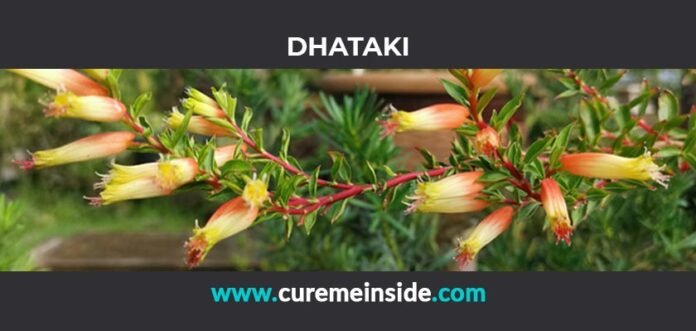Dhataki (Woodfordia fruticosa)
In Ayurveda, Dhataki or Dhawai is also known as Bahupuspika.(HR/1)
The Dhataki flower is very important in traditional Indian medicine. Dhataki’s Kashaya (astringent) quality, according to Ayurveda, is useful for feminine illnesses such as menorrhagia (heavy monthly bleeding) and leucorrhea (white discharge from the vaginal area). These disorders, as well as diarrhoea, can be managed by taking 1/4-1/2 teaspoon of Dhataki powder with honey twice a day.Dhataki powder also helps to regulate Kapha and may be useful in the treatment of asthma since it encourages the elimination of excess mucus from the respiratory system, making breathing easier. Dhataki is useful for skin disorders (such as acne, pimples etc.) and might assist in wound healing due to its antibacterial and anti-inflammatory qualities. Because of its Ropan (healing) and Sita (cooling) characteristics, applying a paste of Dhataki powder to the skin with honey or water reduces edoema and speeds wound healing. This paste can also be used to treat sunburns, acne, and pimples on the skin.
Dhataki is also known as :- Woodfordia fruticosa, Bahupuspi, Tamrapuspi, Vahnijvata, Dhaiphool, Fire flame bush, Dhavadi, Dhavani, Dhai, Dhava, Tamrapushpi, Tattiripuvu, Tatire, Dhayati, Dhavati, Dhaiphula, Dhatuki, Davi, Phul Dhava, Kattati, Kattathi, Kattatipoo, Aarl Puruvu , Parvati, Bahupuspika
Dhataki is obtained from :- Plant
Uses and benefits of Dhataki:-
As per several scientific studies, uses and benefits of Dhataki (Woodfordia fruticosa) are mentioned as per below(HR/2)
- Menorrhagia : Raktapradar, or excessive secretion of menstrual blood, is the medical term for menorrhagia, or severe monthly bleeding. An exacerbated Pitta dosha is to blame. Dhataki regulates heavy menstrual bleeding or menorrhagia by balancing an exacerbated Pitta. Due to its Sita (chill) and Kashaya (astringent) qualities, this is the case. a. Take a quarter to half teaspoon of Dhataki powder. c. Combine with honey or water to make a paste. c. Consume it twice a day after a light meal. c. Do this every day to help with Menorrhagia symptoms.
- Leucorrhea : thick, white discharge from the female genitals is known as leucorrhea. Leucorrhea is caused by a Kapha dosha imbalance, according to Ayurveda. Because of its Kashaya (astringent) quality, Dhataki is beneficial in the treatment of leucorrhea. It aids in the regulation of exacerbated Kapha and the reduction of leucorrhea symptoms. a. Take a quarter to half teaspoon of Dhataki powder. c. Combine with honey or water to make a paste. c. To manage leucorrhea, take it twice a day after a light meal.
- Diarrhea : In Ayurveda, diarrhoea is referred to as Atisar. It is caused by poor nutrition, contaminated water, pollutants, mental tension, and Agnimandya (weak digestive fire). All of these variables contribute to the aggravation of Vata. This worsened Vata draws fluid into the gut from numerous body tissues and mixes it with the excrement. This causes loose, watery bowel movements or diarrhoea. Dhataki aids in the prevention of diarrhoea. This is due to the fact that it is Kashaya (astringent). It thickens loose stool and reduces the frequency of bowel movements or diarrhoea. Tips: a. Take a quarter to half teaspoon of Dhataki powder. c. Combine with honey or water to make a paste. c. To treat diarrhoea, take it twice a day after a light meal.
- Asthma : Dhataki aids in the management of asthma symptoms and provides relief from shortness of breath. The main doshas associated in asthma, according to Ayurveda, are Vata and Kapha. In the lungs, vitiated ‘Vata’ joins with disturbed ‘Kapha dosha,’ obstructing the respiratory path. Breathing becomes difficult as a result of this. Swas Roga is the name for this disorder (asthma). Dhataki powder aids in the balance of Kapha and the removal of excess mucus from the lungs. Asthma symptoms are relieved as a result of this. Tips: a. Mix 1/4-1/2 teaspoon Dhataki powder with honey or water. b. c. Take it twice a day after a light meal to relieve asthma symptoms.
- Wound healing : Dhataki promotes rapid wound healing, reduces swelling, and restores the skin’s natural texture. Dhataki flower powder mixed with coconut oil promotes wound healing and lowers inflammation. This is related to the qualities of Ropan (healing) and Sita (cold). Tips: a. Take 1 to 2 teaspoons of Dhataki powder, or as needed. c. Make a paste with the honey or water. c. Use it once a day on the afflicted region. c. Wait at least 1 hour before washing with normal water. e. Keep doing this till the wound heals quickly.
- Sunburn : Dhataki is beneficial in the treatment of sunburn. Sunburn is caused by an increase in Pitta dosha, according to Ayurveda. This is due to the sun’s constant presence. Because of its Sita (cold) and Ropan (healing) properties, Dhataki flower paste has a cooling effect and minimises burning sensations. Tips a. Take 1 to 2 teaspoons of Dhataki powder, or as needed. c. Make a paste with the honey or water. c. Use it once a day on the afflicted region. c. Wait at least 1 hour before washing with normal water. e. Do this again to relieve sunburn symptoms.
- Acne and Pimples : “A skin type with the Kapha-Pitta dosha can be prone to acne and pimples. Kapha aggravation, according to Ayurveda, promotes sebum production, which clogs pores. Both white and blackheads occur as a result of this. Pitta aggravation also results in red papules (bumps) and pus-filled inflammation. Acne and pimples can be controlled by using Dhataki powder. It decreases irritation while preventing excessive sebum production and pore blockage. Its Kapha and Pitta balancing capabilities are the reason behind this. Tips: a. Take 1 to 2 teaspoons of Dhataki powder, or as needed. c. Make a paste with the honey or water. c. Use it once a day on the afflicted region. c. Wait at least 1 hour before washing with normal water. e. Do this again to get rid of acne and pimples.
Video Tutorial
Precautions to be taken while using Dhataki:-
As per several scientific studies, below precautions should to be taken while taking Dhataki (Woodfordia fruticosa)(HR/3)
Special precautions to be taken while taking Dhataki:-
As per several scientific studies, below special precautions should to be taken while taking Dhataki (Woodfordia fruticosa)(HR/4)
- Breastfeeding : There is insufficient scientific data to support the usage of Dhataki during breastfeeding. As a result, it’s best to avoid Dhataki during breastfeeding or use it only under physician supervision.
- Patients with diabetes : There isn’t enough scientific data to support the usage of Dhataki if you’re using anti-diabetic medications. In this scenario, it is best to avoid Dhataki or use it only under physician supervision.
- Patients with heart disease : There isn’t enough scientific data to support the usage of Dhataki if you’re using anti-hypertensive medication. In this scenario, it is best to avoid Dhataki or use it only under physician supervision.
- Pregnancy : There is insufficient scientific evidence to support the usage of Dhataki during pregnancy. As a result, it is best to avoid Dhataki during pregnancy or use it only under medical supervision.
How to take Dhataki:-
As per several scientific studies, Dhataki (Woodfordia fruticosa) can be taken into the methods mentioned as per below(HR/5)
- Dhataki Powder : Take dried flowers of Dhataki. Grind them and also make powder. Take one fourth to one half teaspoon of this Dhataki powder. Mix with honey or water. Have it twice a day after taking light food, or, Take dried flowers of Dhataki. Grind them and make powder. Take half to one teaspoon of this Dhataki powder or based on your requirement. Mix with honey or water and also make a paste. Apply it on the damaged location once a day. Leave it for at least one hour. Wash with plain water.
How much Dhataki should be taken:-
As per several scientific studies, Dhataki (Woodfordia fruticosa) should be taken into the amounts mentioned as per below(HR/6)
- Dhataki Flower : One fourth to half teaspoon or as per your requirement, or, Half to one teaspoon or as per your requirement.
Side effects of Dhataki:-
As per several scientific studies, below side effects need to be taken into consideration while taking Dhataki (Woodfordia fruticosa)(HR/7)
- There is not enough scientific data available about side effects of this herb yet.
Questions asked frequently Related to the Dhataki:-
Question. Is Dhataki good for female disorders?
Answer. Yes, Dhataki is beneficial to women’s health because it relieves the symptoms of heavy and painful menstruation. Its Kashaya (astringent) function also helps to alleviate the symptoms of leucorrhea.
Question. What are the medicinal uses of Dhataki?
Answer. Dhataki contains a wide range of medical and pharmacological characteristics. The antioxidant and liver-protective properties of dried Dhataki flowers aid in the management of liver ailments. It contains specific compounds (woodfordins) that have analgesic and anti-inflammatory activities, which assist to reduce pain and inflammation. Its anti-ulcer, immunomodulatory, and antibacterial characteristics make it effective in ulcers and infections.
Question. Can Dhataki be used for Abdominal worms?
Answer. Yes, Dhataki can be used to treat abdominal worms because it contains anthelmintic constituents (tannins). It aids in the prevention of parasite and worm growth and the expulsion of parasites and worms from the body.
Because Dhataki possesses the Krimighna (Anti Worms) function, it can be used to limit the proliferation of worms in the digestive tract. It aids in the prevention of worm growth and the removal of worms from the abdomen.
Question. Is Dhataki beneficial in diarrhoea and dysentery?
Answer. Yes, Dhataki has been shown to help with dysentery and diarrhoea. Because of its antibacterial properties, it prevents the growth of germs that cause dysentery and diarrhoea. Due to its astringent properties, it also reduces intestinal motility and secretions by constricting the mucus membrane.
Because of its Kashaya (astringent) quality, Dhataki is a useful plant for controlling the symptoms of diarrhoea and dysentery. It reduces the symptoms of diarrhoea and dysentery by reducing the frequency of watery stools.
Question. Can Dahataki be used for ulcers?
Answer. Because of its antiulcer properties, Dhataki can be used to treat ulcers. Because of its antioxidant and gastroprotective characteristics, it has a component (ellagic acid) that protects gastric cells from free radical damage.
Because of its Pitta-balancing properties, Dhataki can be utilised to alleviate ulcer symptoms. It relieves the symptoms of ulcers by preventing excessive stomach acid output. Because of its Sita (cold) nature, it also has a cooling effect.
Question. What are the benefits of Dhataki for dental problems?
Answer. Dhataki’s analgesic (pain-relieving) characteristics make it useful for dental disorders including toothaches. It relieves dental discomfort by reducing inflammation and pain in the afflicted area.
Question. Is Dhataki helpful in eye problems?
Answer. There isn’t enough scientific data to back up Dhataki’s role in eye disorders.
SUMMARY
The Dhataki flower is very important in traditional Indian medicine. Dhataki’s Kashaya (astringent) quality, according to Ayurveda, is useful for feminine illnesses such as menorrhagia (heavy monthly bleeding) and leucorrhea (white discharge from the vaginal area).




